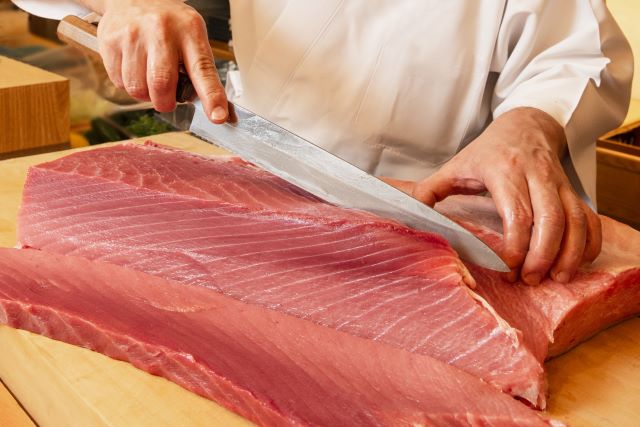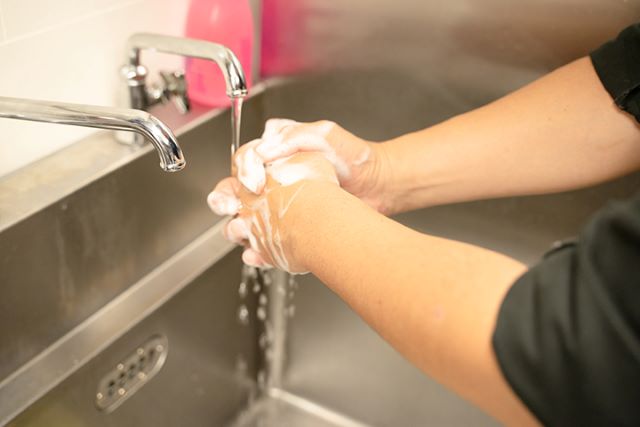
We would like to examine this challenging title that appears regularly in the media.
This story has not recently come to a boil; in fact, it is already widely known. However, the reason it is a recurring topic is due to the fact that the assumptions between the writer and the reader do not match. The reason for this is that the writer tends to exaggerate a bit in order to get people to read the article. The readers, on the other hand, are overwhelmingly uninformed and are led to feel uneasy about what they hear. Here’s what we guess.
So, in order to explain this issue properly, we will squash any ambiguities.
There are three major risks.
The first is food poisoning due to bacterial growth. The second is food poisoning by parasites. The third is the medium- to long-term effects on the human body of mercury, dioxin, microplastics, and other substances that accumulate in tunas.

We can say that food poisoning caused by bacterial growth is a very rare and serious matter that can affect the survival of a business, if only in sushi restaurants. Here are some data to support this. According to data from the Tokyo Metropolitan Government, the percentage of food poisoning cases occurring at sushi restaurants is less than 0.8% of the total number of food poisoning cases. The data shows that food poisoning rarely occurs at sushi restaurants.
The reasons for this are largely related to soy sauce, salt, and vinegar. First, soy sauce has bacteriostatic properties, and by marinating tunas and other fish in soy sauce, the growth of bacteria is inhibited. Second, salt has a bactericidal effect, killing bacteria on the surface of the fish. Besides, it uses osmosis to expel the rotting components of fish meat, etc. And vinegar also has a sterilizing effect. Since the ㏗ is 2~4, the bacteria are almost killed when they come in contact with vinegar. Sushi chefs put vinegar on their hands or wipe their knives with a cloth dipped in vinegar to sterilize them. Shari is made with vinegar and salt, so it is also sterilized. In other words, more steps are taken to prevent the growth of bacteria than in any other dish.
Next, we will examine food poisoning caused by parasites; Anisakis accounts for 50% of all cases of food poisoning. It can be said that raw seafood always contains parasites, but removing these parasites is the foundation of a sushi restaurant, and Anisakis, which can be visually identified, cannot be overlooked. On July 2, 2021, a method to kill Anisakis with a high current was also announced and will soon be put to practical use.
Also, it totally depends on where you eat. Do you buy it at the supermarket or fish market and eat it at home or a sushi restaurant? Even at the same sushi restaurant, there is a difference. Is it a conveyor-belt sushi restaurant with a chain or an individual restaurant run by a master and his apprentice? In our opinion, however, food poisoning caused by Anisakis has not occurred in private restaurants.
We will examine the medium- and long-term effects of toxic chemicals. First, let’s look at the effects of mercury. For example, the level of effect is naturally different for those who consume tuna every day and those who eat tuna once a week. Although the Japanese eat a lot more tuna than other countries, the effects of mercury accumulated in tuna have not yet been widely discussed. The effects of mercury on the mother’s body are well known, and the following warning is given by the doctor in charge.
In Japan, if you eat more than 160 grams of tuna per week, you need to be careful. Pregnant women do not bother to eat 160 grams of tuna in the first place. In addition, although Kuromaguro (Bluefin tuna), Mebachi (Bigeye tuna), and Minamimaguro (Southern Bluefin tuna) have safe amounts, Kihada (Yellowfin tuna), Binnaga (Albacore), and Mejimaguro (Young bluefin tuna) do not require any restrictions on the amount eaten. Also, there is no need to worry about canned tuna. This is also a well-known story.
And, this may come as a shock to tuna lovers, but it is the toro part of the belly that tends to accumulate the most dioxin, which is considered the best part of the fish. The toro is mostly fat, and dioxin taken in from feed and seawater accumulates there. In nature, the toro portion of tuna is normally about 20% of the tuna meat. However, in fattened tunas, 70~80% of the body is toro. The meat of fattened tuna is a habitat for dioxin. According to some research data, the amount of dioxin accumulated in fattened Kuromaguro was about 2 to 3 times higher than that in wild tuna, and in fattened Minamimaguro, it was about 2 to 10 times higher.
The final section examines microplastics’ medium- and long-term effects on the human body.
In the North Pacific Ocean gyre, famous for the Pacific Garbage Belt, plastic fragments have been found in the digestive tracts of 10%-35% of the fish examined. Many researchers have noted that microplastics are vectors that bridge harmful pollutants to fish and marine life. U.S. health officials estimate that less than 0.3% of microplastics taken into the human body reach the body’s lymphatic and circulatory systems from the gut. And only a very small fraction of these microplastics affect the body’s organs. Still, the effects of microplastics taken into the body on human health are not fully understood.
In 2014, the Ministry of the Environment’s survey on the actual state of marine debris reported that the amount of microplastics in the waters surrounding Japan was 16 times more than in the North Pacific Ocean and 27 times more than in the world’s oceans. And yet, around 2020, major media outlets are only now beginning to report on the issue. Unfortunately, this is one of the topical issues that Japan is still turning a blind eye to. In fact, this is a more serious problem in the world, and we imagine it will be sensationalized soon. We should put some restrictions on countries and companies dumping plastics into the oceans. Japan must be proactive in this regard in order to achieve the SDGs.
In conclusion, we think this title comes from the media’s self-righteousness.
We are not a researcher and cannot say that it is absolutely safe. It is a medium- to long-term issue that should not be neglected with careful monitoring. But in general, Tuna is an expensive food, so it should be economically difficult to consume it in large quantities. Instead, the media should focus on rice, wheat, corn, and other foods that are consumed daily. For your information.
Related contents:
Worried about mercury in fish? California researchers find a possible fix
We hope this information will be helpful.

Revision date: May 2, 2025
Share this article